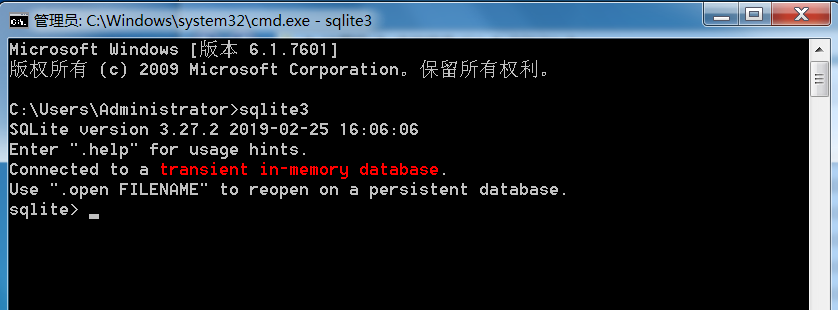

- #Sqlite command line script update
- #Sqlite command line script archive
- #Sqlite command line script code
- #Sqlite command line script download
- #Sqlite command line script windows
Self.db.execute("CREATE TABLE %s(%s)"%(tablename, fieldlist))
#Sqlite command line script code
If I run the sqLite3 tool in powershell then it works fine (sqlite3.exe 'mydatabase.db' '.read mySql.sql') But when I run the sqlite3 tool from my c code as a process, then nothing happens to mydatabase.db. Self.db.execute("DROP TABLE IF EXISTS %s"%tablename) I'm trying to run the sqlite.exe tool as a process in my c code in order to read a sql from a file. I nedded to import many csv files, so I wrote the following python script that does the job of creating and loading sqlite tables from csv files, using the first line of the csv as the field names for the table: #!/usr/bin/env pythonĭef importFromCSV(self, csvfilename, tablename, separator=","):

"IMPORT INTO TESTDB.test SELECT local_port AS port, COUNT(local_port) AS hitcount FROM connections WHERE connection_type = 'accept' GROUP BY local_port ORDER BY hitcount DESC " "CREATE TABLE TESTDB.test (name varchar(255) not null, blah varchar(255) not null) " Or: "ATTACH 'c:\directory\to\database\test.db' as TESTDB " In the official sqlite web page is a section called Writting results to a file but doesn't. tables > newdboutput.txt) because sqlite runs as an a program under the command line.
#Sqlite command line script windows
"CREATE TABLE TESTDB.test AS SELECT local_port AS port, COUNT(local_port) AS hitcount FROM connections WHERE connection_type = 'accept' GROUP BY local_port ORDER BY hitcount DESC " I'm doing some queries using Sqlite in Windows (I execute it as sqlite3 mydb.db) but I can't redirect the output (I'm trying to do as a normal command line way like. So basically, you'd run (from your PHP Page): "ATTACH 'c:\directory\to\database\test.db' as TESTDB " You can attach a new database, create the table in it, and import to its table, so you don't have the extra step of exporting to CSV then reparsing. One other approach which you might not have considered is the ATTACH command. Where the content of import.sql is: CREATE TABLE test (name varchar(255) not null, blah varchar(255) not null) Like so: sqlite3.exe test.sqlite < import.sql
#Sqlite command line script archive
(The file sqldiff.c is located in the tool sub-directory of the archive containing the sources.I'd recommend doing your importation from a flat file, which will create your schema followed with the actual importation:
#Sqlite command line script download
If you need 64-bit binaries, then you have to download the raw sources and compile them by yourself. Here are the links to sqldiff of version 3.8.10: For example, here are the links to the sqlite tools archives of version 3.42.0:įor SQLite versions prior to version 3.10.2, the SQLite website hosts 32-bit binaries for sqldiff, but does not link to them. They can be found in the sqlite tools archives for the corresponding operating systems (see the Precompiled Binaries sections). Since SQLite version 3.10.2 which was released on January 20, 2016, the 32-bit binaries for sqldiff can be directly downloaded from the SQLite Download Page.
#Sqlite command line script update
UPDATE my_table_size SET counter=0 WHERE rowid=1 I then ran sqldiff.exe again, but this time with with db2.sqlite as first argument and db1.sqlite as second argument: sqldiff db2.sqlite db1.sqlite The table my_table_size was automatically updated by a TRIGGER after the key-value pair was inserted to my_table. UPDATE my_table_size SET counter=1 WHERE rowid=1 INSERT INTO my_table(rowid,"key",value) VALUES(1,'D:\Test\Test.txt',x'aabbccdd') After that I ran the following command: sqldiff db1.sqlite db2.sqlite I then inserted one key-value pair intoĭb2.sqlite. I took a simple key-value store database ( db1.sqlite) and madeĪ copy of it ( db2.sqlite). For example, the sqldiff.exe utility (at least currently) does not display differences in TRIGGERs, VIEWs, or virtual tables. However, there are also certain limitations. If no options are specified, then the output of sqldiff.exe is SQL statements that will transform database1.sqlite (the "source" database) into database2.sqlite (the "destination" database). Example usage: sqldiff database1.sqlite database2.sqlite The sqldiff.exe command-line line tool should work for all supported operating systems and offers several switches for altering its output behavior. Most likely this program will also be part of future releases. This release for the first time contains the sqldiff.exe utility program for computing the differences between two SQLite database files. Please have a look at the SQLite Release 3.8.10 which was released on May 7, 2015.


 0 kommentar(er)
0 kommentar(er)
